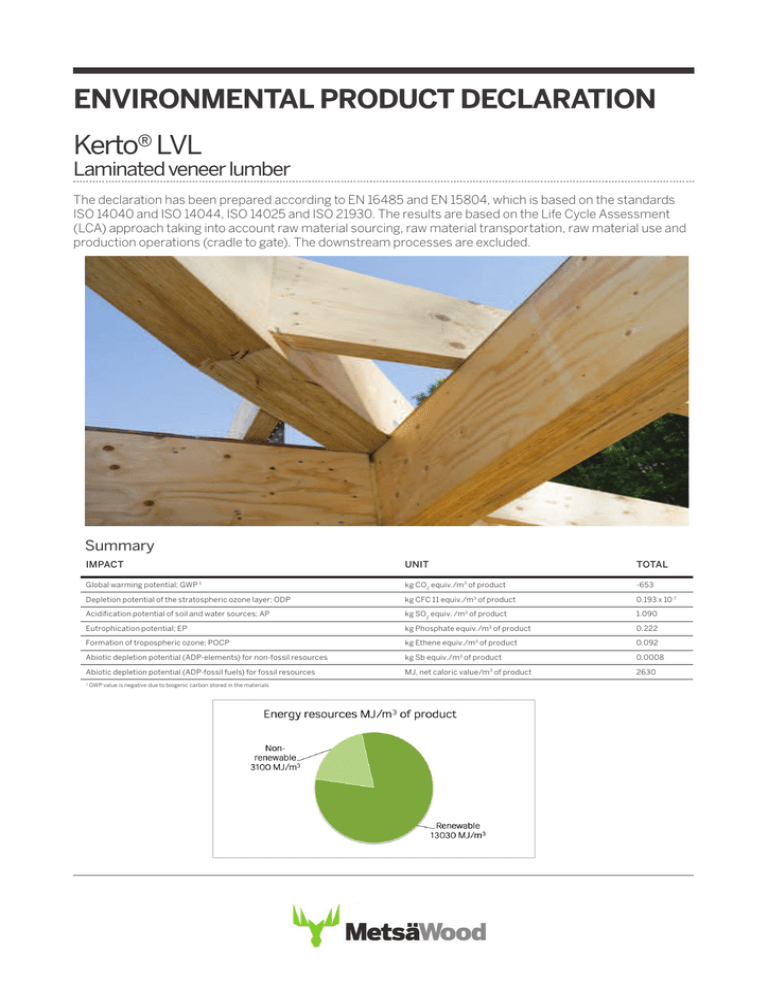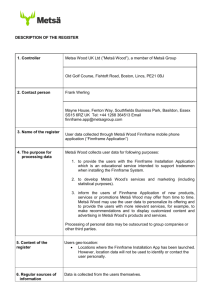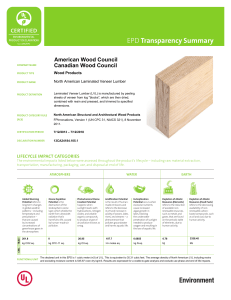ENVIRONMENTAL PRODUCT DECLARATION Kerto® LVL
advertisement

ENVIRONMENTAL PRODUCT DECLARATION Kerto® LVL Laminated veneer lumber The declaration has been prepared according to EN 16485 and EN 15804, which is based on the standards ISO 14040 and ISO 14044, ISO 14025 and ISO 21930. The results are based on the Life Cycle Assessment (LCA) approach taking into account raw material sourcing, raw material transportation, raw material use and production operations (cradle to gate). The downstream processes are excluded. Summary IMPACT Global warming potential; GWP UNIT 1 TOTAL 3 kg CO2 equiv./m of product -653 Depletion potential of the stratospheric ozone layer; ODP kg CFC 11 equiv./m3 of product 0.193 x 10-7 Acidification potential of soil and water sources; AP kg SO2 equiv. /m3 of product 1.090 Eutrophication potential; EP kg Phosphate equiv./m3 of product 0.222 Formation of tropospheric ozone; POCP kg Ethene equiv./m3 of product 0.092 Abiotic depletion potential (ADP-elements) for non-fossil resources kg Sb equiv./m3 of product 0.0008 Abiotic depletion potential (ADP-fossil fuels) for fossil resources MJ, net caloric value/m3 of product 2630 1 GWP value is negative due to biogenic carbon stored in the materials SCOPE OF THE DECLARATION INCLUDED Raw material supply FORESTY OPERATIONS Transport OTHER RAW MATERIALS Manufacturing TRANSPORT KERTO LVL PRODUCTION 1. PRODUCT DESCRIPTION 1.2 HANDLING AFTER USE Kerto® LVL laminated veneer lumber products are used in all types of construction projects, from new buildings to renovation and repair. Kerto LVL is incredibly strong and dimensionally stable, and it does not warp and twist. Kerto LVL derives its high strength from the homogeneous bonded structure manufactured from a long-grained Nordic conifer. - Products: Kerto-S, Kerto-Q, Kerto-Qp, Kerto-T, Kerto-L - Primary applications: beam, column and panel structures - Instructions for use comply with Eurocode 5 requirements Kerto LVL can be disposed of in several ways. It should be noted that the instructions for disposal may vary by country depending on the current legislation. Physical properties - Mean density: Kerto-S, Kerto-Q, Kerto-Qp (RH65%, 20°C) 510 kg/m3 - Mean density: Kerto-T, Kerto-L (RH65%, 20°C) 440 kg/m3 - Moisture content (delivered from the mill): 8-10% Composition - Wood (coniferous veneers) - Phenol formaldehyde adhesive* - Melamine formaldehyde adhesive (surface veneer scarf-joints)* * Adhesives do not contain chlorine or heavy metals Kerto LVL is manufactured at the Lohja and Punkaharju LVL mills in Finland. More information can be obtained at www.metsawood.com. Recycling Kerto LVL by utilising it in other applications is always preferred. However, Kerto LVL can be safely burnt when the combustion temperature is at least 850°C; the combustion air and gases are well mixed; the retention time of the combustion gases in the furnace is over two seconds; and the residual oxygen content of the flue gases is over 6%. Gross heating value is 19.4 MJ/kg. While the products can also be composted, the panels need to be chipped and the long composting process has to be taken into consideration. The products can also be taken to a refuse dump, although Kerto LVL will degrade very slowly. Kerto LVL does not contain anything classified as hazardous waste and has the following waste code under the consolidated European Waste Catalogue: - 170201 Wood (Construction and Demolition Wastes) 2. SCOPE OF DECLARATION 1.1 CERTIFICATES Metsä Forest, part of Metsä Group, is the only wood supplier for Metsä Wood mills in Finland. Metsä Forest, as well as Metsä Wood’s Lohja and Punkaharju LVL mills, have certified PEFC™ and FSC® Chain of Custody, and certified quality (ISO 9001) and environmental (ISO 14001) management systems in place, which include a wood origin tracking system. Thorough documentation and the latest technology, including digital maps, are used to track the wood flow from the forest to the mill. Metsä Forest fulfils the obligations of European Union Regulation No. 995/2010 (EU Timber regulation), which prohibits the placing and trading of illegally harvested timber and timber products on the market. As all the wood raw material is covered by Chain of Custody certification, Metsä Wood knows the origin of all the wood it uses. The PEFC™ logo on the product ensures that 100% of the wood raw material is legally harvested, and at least 70% is sourced from certified forests. Kerto LVL products are CE marked according to standard EN 14374. The following processes are included in the scope of the environmental product declaration: PROCESSES OF RAW MATERIAL SUPPLY: Forestry operations; production of glues. PROCESSES OF TRANSPORT AND MANUFACTURE: Production and transportation of energy, fuels, lubricants and packaging materials. Production of Kerto LVL. Transportation and the treatment of landfill and recycling waste. Transportation of hazardous waste. THE FOLLOWING PROCESSES HAVE BEEN EXCLUDED: The construction and maintenance of factory buildings and related infrastructure; the treatment of hazardous waste and waste recycled by composting; the transportation of the finished product from mill to customer; construction process stages; and the use and end-of-life stages. EXCLUDED ENERGY PACKAGING WASTE MANAGEMENT PRODUCTION FACILITIES DISTRIBUTION END-USER DISPOSAL 3. USE OF RESOURCES 4. PRODUCT’S POTENTIAL ENVIRONMENTAL IMPACTS The use of resources and emissions are calculated per one cubic meter (1 m3) of product. The results are presented according to EN 15942. Potential environmental impacts were estimated using CML2001-Apr. 2013 factors. 3.1 USE OF PRIMARY ENERGY AND FRESH WATER PRODUCT STAGE USE OF PRIMARY ENERGY (MJ, NET CALORIFIC VALUE/ M3 OF PRODUCT) Use of renewable primary energy excl. raw materials Use of renewable primary energy resources used as raw materials Total use of renewable primary energy resources RAW MATERIAL SUPPLY TRANSPORT 2540 10 8130 1 10670 0 10 MANUFACTURING (ENERGY, PACKAGING, WASTE HANDLING) 2350 0 2350 PRODUCT STAGE TOTAL IMPACT UNIT/M3 OF PRODUCT RAW MATERIAL SUPPLY TRANSPORT MANUFACTURING TOTAL Global warming potential; GWP 1 kg CO2 equiv. -982 13 316 -653 4900 Depletion potential of the stratospheric ozone layer; ODP kg CFC 11 equiv. 0.286 x 10-9 0.534 x 10-10 0.189 x 10-7 0.193 x 10-7 Acidification potential of soil and water sources; AP kg SO2 equiv. 0.445 0.062 0.585 1.090 Eutrophication potential; EP kg Phosphate equiv. 0.092 0.016 0.114 0.222 Formation of tropospheric ozone; POCP kg Ethene equiv. 0.063 -0.023 0.052 0.092 Abiotic depletion potential (ADPelements) for non fossil resources kg Sb equiv. 0.0008 0.509 x 10-6 0.215 x 10-5 0.0008 Abiotic depletion potential (ADPfossil fuels) for fossil elements MJ, net caloric value 1860 179 591 2630 8130 13030 Use of non-renewable primary energy excl. non-renewable primary energy resources used as raw materials 820 Use of non-renewable primary energy resources used as raw materials 1120 0 0 1120 Total use of non-renewable primary energy resources 1940 180 980 3100 180 980 1980 USE OF FRESH WATER 1 GWP value is negative due to biogenic carbon stored in the materials (KG/M3 OF PRODUCT) Water consumption 1 1520 20 Mainly solar energy that is bound in wood during its growth 560 2100 4.1 CARBON FOOTPRINT Carbon footprint is a life cycle assessment (LCA) with climate change as the single impact category. To quantify the climate change impact of the product, global warming potential (GWP) has been used. Kerto LVL’s GWP -653 kg CO2 equiv./m3 is presented in the table above. It covers a partial LCA from cradle to gate. At the mill gate, the GWP is negative due to the carbon stored in the product. 5. OTHER ENVIRONMENTAL INFORMATION 5.1 EMISSIONS TO INDOOR AIR Determined according to EN 717-1, the formaldehyde emitted by Kerto LVL falls far below the Class E1 requirement of ≤ 0.100 ppm and also fulfils the most stringent requirements in the world (≤ 0.030 ppm). The formaldehyde emission of Kerto LVL is approximately 0.016 ppm. Kerto LVL also has the M1 Finnish emission classification for building materials. 5.2 WASTES BY CATEGORY DISPOSED WASTE, KG (WET WEIGHT)/M3 OF PRODUCT 1 WASTE CATEGORY RAW MATERIAL SUPPLY TRANSPORT Hazardous 0.014 Non-hazardous Radioactive 1 MANUFACTURING TOTAL 0.000 0.782 0.796 0.210 0.060 2.240 2.510 0.005 0.0002 0.156 0.161 2 Ozone depletion: Ozone is an essential substance in the upper atmosphere (the stratosphere) where it screens out more than 99% of the dangerous ultraviolet radiation from the sun. Stratospheric ozone depletion refers to the thinning of the stratospheric ozone layer as a result of anthropogenic emissions of halons used as refrigerants in fire extinguishers and other applications. Photochemical ozone creation: Ozone in the lowest layer of the atmosphere is harmful for living organisms. It is formed when traffic emissions such as nitrogen oxides (NOx) and volatile organic hydrocarbons (VOCs), for example, react in the sunlight. 7. VERIFICATIONS Date of publication: February 2015 Validity: until January 2020 Data reference year: 2013 Mainly originates from datasets used for electricity supply 5.3 OUTPUT FLOWS 1 Global warming potential (GWP): Global warming is caused by the increase of greenhouse gases in the atmosphere, such as carbon dioxide (CO2) that absorbs heat. GWP is calculated over a specific time period of 100 years (GWP100). OUTPUT FLOW UNIT/M3 OF PRODUCT KERTO LVL PRODUCTION Components for re-use kg (wet weight) 0.00 Materials for recycling kg (wet weight) 1.02 Materials for energy recovery 1 kg (wet weight) 329 Exported energy 2 MJ 8.18 By-products, as wood chips and bark, used for energy recovery in the own manufacturing process The heat or electricity generated in incineration of wastes and landfilling process that are not used in own manufacturing processes 5.4 CO2 STORED IN THE PRODUCT Kerto LVL (1 m3) contains the stored carbon equivalent to 789 kg CO2 stored in wood. Metsä Wood’s certification systems guarantee the sustainability and traceability of wood raw materials (see 1.1). European standard EN 15804 serves as the core PCR. Independent verification of the declaration, according to ISO 14025:2010 internal external Third party verifier: Inspecta Sertifiointi Oy (accredited environmental verifier) Note: EPD of construction products may not be comparable if they do not comply with the European standard EN 15804. 8. REFERENCES EN 15804:2012. Sustainability of construction works. Environmental product declarations. Core rules for the product category of construction products. 6. DEFINITIONS EN 15942:2011. Sustainability of construction works. Environmental product declarations. Communication format business-to-business. Acidification: Occurs when the capacity of soil or water bodies to resist or neutralise acidifying atmospheric deposition begins to decline. It is caused by combustion gases, such as nitrogen and sulphur oxides (SOx) that react in the atmosphere to produce acids. EN 16485:2014. Round and sawn timber – Environmental Product Declarations – Product category rules for wood and wood-based products for use in construction. CML2001-Apr.2013: An impact assessment method developed at the University of Leiden, Centre of Environmental Studies (CML). Depletion of abiotic resources: Consumption of non-renewable resources, such as zinc ore and crude oil, thereby lowering their availability for future generations. Eutrophication: Eutrophication is caused by an addition of excess nitrogen and phosphorus nutrients to an eco-system, e.g. through waste waters. This boosts the growth of planktonic algae leading to reduced water clarity, oxygen depletion or changes in fish stocks. Origin of generic data: GaBi 6 Professional database and LIPASTO. – A calculation system for traffic exhaust emissions and energy consumption in Finland (http://lipasto.vtt.fi/). LEGAL NOTICE This Environmental Product Declaration is provided for information purposes only and no liability or responsibility of any kind is accepted by Metsä Wood or their representatives, although Metsä Wood has used reasonable efforts to verify the accuracy of any advice, recommendation or information. Metsä Wood reserves the right to alteration of its products, product information and product range without any notice. Metsä Group is a responsible forest industry group whose products’ main raw material is renewable and sustainably grown northern wood. Metsä Group focuses on tissue and cooking papers, fresh forest fibre paperboards, pulp, wood products, and wood supply and forest services. Its high-quality products combine renewable raw materials, customer-orientation, sustainable development and innovation. Metsä Group’s sales totalled EUR 5 billion in 2014, and it employs approximately 10,500 people. The Group operates in some 30 countries. Metsäliitto Cooperative is the parent company of Metsä Group and is owned by approximately 122,000 Finnish forest owners. Metsä Wood provides competitive and environmentally friendly wood products for construction, industrial customers and distributor partners. We manufacture products from northern wood, a sustainable raw material of premium quality. Our sales in 2014 were EUR 0.9 billion, and we employ about 2,300 people. Metsä Wood is part of Metsä Group. METSÄ WOOD P.O. Box 24 FI-08101 Lohja, Finland Telephone: +358 10 4656 499 Telefax: +358 10 4656 222 www.metsawood.com

